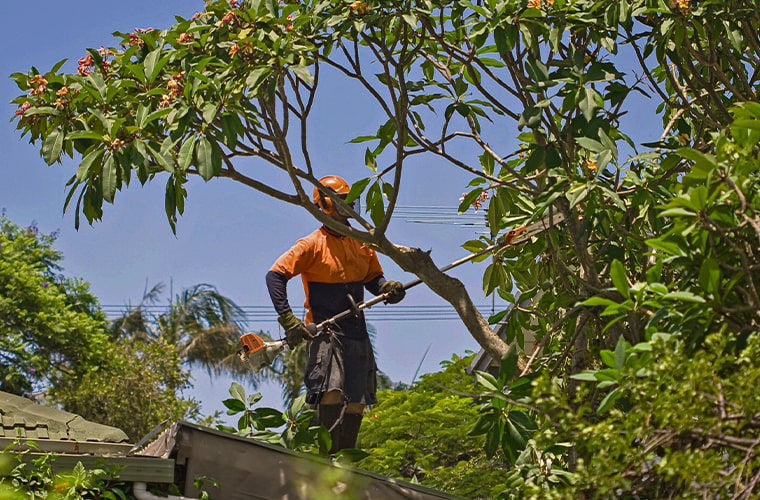Who is responsible for cutting overhanging tree branches
Understanding who is responsible for cutting overhanging tree branches is critical for tree care safety, aesthetic appeal, and legal compliance. Overhanging branches can endanger property and people; thus, their management requires experience and care.
Reasons for Cutting Overhanging Tree Branches
Cutting overhanging tree branches is critical for a variety of reasons. Overhanging branches can endanger people, vehicles, and structures, particularly during storms; thus, safety is vital. Another important reason is to avoid property damage since branches can scratch roofs, walls, and windows, requiring expensive repairs. Pruning improves tree health by removing damaged or dead branches that may have an impact on the tree’s overall vitality. Property owners may face legal accountability for damages caused by fallen branches. Finally, maintaining aesthetic appeal and guaranteeing clear vistas are practical issues that increase property value and enjoyment.
Who is responsible for cutting overhanging tree branches
Find out if the tree is on your land

To determine whether or not a tree is on your land, you must check property borders. Examine your property deed or land survey for specific boundary lines. Locate boundary markers such as stakes, fences, or walls. The tree is considered yours if its trunk completely falls within your property lines. A GPS property boundary app or a professional surveyor can help you get more precise results. Clear identification promotes responsible tree maintenance and helps to prevent neighborly problems.
What if there’s a boundary dispute
In the event of a boundary dispute over a tree, begin by chatting with your neighbor to understand their point of view and reach a mutual understanding. Check property deeds and land surveys for the correct boundary information. If the debate continues, consider engaging a professional surveyor to provide an unbiased opinion. Mediation services might help you reach an acceptable resolution. If necessary, seek guidance from a property attorney before taking legal action. Document all discussions and agreements to avoid future issues. Addressing border issues calmly and professionally leads to a fair and happy resolution.
Who pays to cut overhanging branches?
Typically, the tree’s property owner is responsible for its upkeep and associated costs. However, if branches spill onto a neighbor’s land, the neighbor has the right to trim them at their own expense, as long as the trimming does not harm the tree. Neighbors should communicate and form an agreement on costs and duties. In some circumstances, joint costs can be agreed upon, particularly if the branches are of common significance.
How Can Homeowners Take Action?
Homeowners can take proactive measures to efficiently manage overhanging tree branches. Regularly inspect trees for any threats or encroachments. Communicate with your neighbors to address any concerns and agree on reducing obligations. Hire a licensed arborist to provide expert advice and ensure proper pruning procedures that improve tree health and safety. To avoid legal complications, become familiar with local tree upkeep and property boundary restrictions. If you have a border disagreement, consider mediation or a professional survey to resolve it amicably. Regular maintenance not only protects property and people, but also increases the tree’s lifespan and aesthetic value.
Legal and ownership considerations
Property boundaries and responsibility
Frequently, property boundaries are used to determine liability for overhanging tree branches. According to customary legal principles, a property owner has the authority to cut branches that extend onto their land. However, it’s crucial to adhere to local laws and show consideration for nearby residences.
Legal Implications
Failure to treat overhanging branches correctly can result in legal consequences. If negligence is shown, property owners are usually held accountable for the harm caused by falling branches. As a result, proactive management of overhanging branches is essential for safety and legal compliance.
What are the best practices for cutting overhanging tree branches?
Assessing tree health and structural integrity
Before pruning any overhanging branches, check the tree’s health and structural stability. Engaging a qualified arborist assures that the trimming procedure supports tree health while reducing the risks associated with diseased or weakening branches.
Proper pruning techniques
Pruning overhanging branches demands suitable procedures. This includes making clean cuts at the branch collar to promote healing and lower the danger of infection. Strategic pruning takes into account the tree’s natural development patterns in order to maintain both its aesthetic appeal and structural soundness.
Equipment and safety measures
Pruning overhanging branches carries inherent dangers, including falls and injury. Employing safety procedures and equipment, such as harnesses, ropes, and cutting tools, protects workers and onlookers. Following industry norms and rules reduces hazards while increasing efficiency.
Related Posts:
Environmental Impact and Tree Preservation
Promoting Tree Health and Longevity
Responsible pruning procedures not only handle the immediate issue of overhanging branches but also promote tree health and longevity. Pruning promotes healthy growth while reducing the risk of future problems by removing dead or diseased branches and increasing ventilation.
Environmental considerations
Cutting down overhanging tree branches requires maintaining ecological equilibrium. Minimizing harm to wildlife habitats and protecting biodiversity are critical issues. Selective pruning strategies promote environmental sustainability and complement conservation initiatives.
Community engagement and neighborhood relations
Communicating with the neighbors
Effective discussions with neighbors about cutting overhanging trees foster good community ties. Discussing aims, timetables, and potential consequences encourages mutual understanding and teamwork in sustaining shared areas.
Professional consulting and mediation
Seeking professional guidance might help to resolve issues about overhanging branches amicably. Mediation services offered by trained arborists or legal professionals provide objective advice based on local rules and best practices.
FAQS
Can I lawfully chop overhanging branches off my neighbor’s tree?
Yes, property owners can legally trim overhanging branches on their property. It’s best to contact your neighbor ahead of time and make sure the pruning follows municipal standards for tree trimming and property boundaries.
What if I want to trim branches that cross a public walkway or street?
Trimming branches over public spaces necessitates conformity with local legislation and regulations. Municipal authorities or professional tree care organizations are responsible for trimming public spaces to maintain safety and compliance.
Am I accountable if a branch from my tree falls and damages my neighbor’s property?
If property owners demonstrate negligence in tree upkeep, they are generally accountable for damages caused by falling branches. Regular inspections and pruning can reduce risks and avoid potential liability issues.
How often should you trim overhanging tree branches?
Tree species, growth rate, and proximity to structures influence the frequency of trimming overhanging branches. We generally suggest inspecting trees once a year and trimming branches as needed to maintain their safety and health.
Should I engage a professional to cut overhanging tree branches?
Hiring a qualified arborist or professional tree care provider guarantees safe and efficient pruning. Professionals have the knowledge and equipment to perform tree cutting while reducing dangers and maintaining tree health.
Conclusion
Determining who is responsible for cutting overhanging tree branches and who is accountable for trimming overhanging tree branches necessitates a combination of legal knowledge, practical experience, and environmental stewardship. Maintain legal compliance, and contribute to long-term tree care practices by following reasonable procedures, Property owners assure safety,




